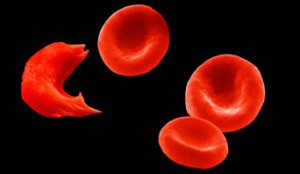Sickle cell anemia is a blood disorder caused by inherited abnormal hemoglobin (the oxygen-carrying protein within the red blood cells).
In fact, circulatory RBCs are flexible and round, moving easily through the blood vessels. In sickle cell anemia, the RBCs become rigid, sticky and are sickle shaped. These irregularly shaped cells when stuck in small blood vessels will slow or block blood flow and oxygen to parts of the body.
Causes
Sickle cell anemia, caused by a mutation in the hemoglobin preparing gene – the red, iron-rich compound that gives blood its red color. Hemoglobin is a pigment that allows RBCs to carry oxygen from lungs to all parts of the body. In sickle cell anemia, the abnormal hemoglobin causes RBCs to become sticky, rigid and misshapen.
The sickle cell gene is an autosomal recessive inherited which means that both the mother and the father must pass on the defective form of the gene for a child to be affected.
Symptoms
Signs and symptoms of sickle cell anemia often don’t appear until an infant is at least 4 months old and may include:
• Anemia
• Episodes of pain.
• Hand-foot syndrome.
• Frequent infections.
• Delayed growth.
• Vision problems.
Prevention
Though finding the sickle cell anemic victim is quite challenging, people have to try to prevent the disorder in anyways. If one carries the sickle cell trait, he/she may wish to see a genetic counselor before trying to conceive a child. A genetic counselor can help you understand the risk of having a child with sickle cell anemia. He or she can also explain possible treatments, preventive measures and reproductive options.

